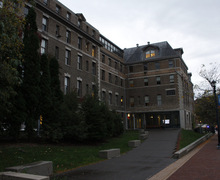Syracuse University professors make a breakthough in disease-causing bacteria
It stains teeth, clogs pool filters and causes 45,000 deaths annually, but the complex microorganism known as biofilm is still not very well understood. After three years of painstaking work, however, two Syracuse University professors are making a breakthrough in the field.
SU professors Dacheng Ren and Yan-Yeung Luk have created a platform to control biofilm formation in specific patterns over extended periods of time. They can now manipulate and confine biofilm growth four times longer than previous technologies.
Biofilms are formed by microbes such as bacteria that create a sticky, slimy buildup on almost any kind of surface under moist conditions. Biofilms can corrode the hulls of ships, produce green slime on rocks and pollute drinking water systems, according to an SU News report.
‘In simple words, bacterial biofilm is referred to as bacteria that attach to a surface,’ Ren said.
When you go to the dentist and they scrape plaque off your teeth, that is biofilm. It can also be the slippery material on the sides of pools, and it can attach to medical implants such as knee, shoulder and hip implants. People with cystic fibrosis often die because of biofilm infections rather than directly from the disease, Ren said.
Bacteria that colonize a surface can tolerate a concentration of antibiotics 1,000 times higher than free-swimming bacteria can, Ren said. Currently, there is no effective way to cure patients with a biofilm-related disease.
Ren, an assistant professor in the department of biomedical and chemical engineering and Luk, an assistant professor in the department of chemistry, used expertise from both of their fields in the breakthrough. The two manipulated the chemical makeup of a surface to study how mammalian cells and bacteria adhere to surfaces in general.
‘It is an interdisciplinary work,’ Ren said. ‘Dr. Luk and I started working on biofilm control by surface engineering … in 2006 and have continued successfully since then.’
‘The mechanism from biofilm formation is still not fully understood, and our creation will enable us to study it. It will also let us explore a platform for drug discovery,’ Ren said.
Biofilm formation causes billions of dollars in losses and more than 45,000 deaths every year in the U.S. alone due to the problems of persistent accumulation in the industry and chronic infections in humans, Ren said.
‘These can be dental problems, infections with implanted medical devices, and currently there is no way to effectively control biofilm since biofilm formation is poorly understood.’
‘One of the key challenges in biofilm research is the lack of well controlled surfaces, which causes inconsistent or even contradictory results especially for studies at the genetic level. Our platform addresses this challenge and therefore is useful for biofilm research,’ Ren said.
Now that the two have identified a way to control biofilm formation in certain circumstances, they are now experimenting with different sizes and shapes that can answer questions about how bacteria responds to changes in local chemical and physical environments.
The concept of a biofilm surface has been around since early 1990, while Luk has been studying the area for more than nine years. With the new discoveries the two have made, they hope that there will be new ways to prevent biofilm damage.
‘As we learn more about biofilm and the surfaces it attaches to we can continue to guide the cells into different patterns and shapes and continue our research on the topic,’ Ren said. ‘We will be continuing research with the grants Dr. Luk and I have been given and collaborate to improve our understanding of biofilm formation and find new ways to control it.’
Published on April 21, 2009 at 12:00 pm





